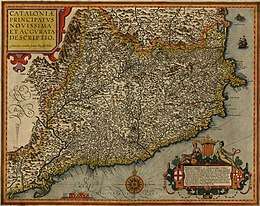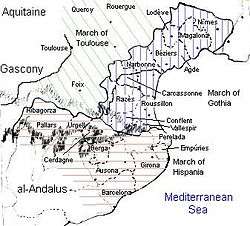Catalan counties
Part of a series on the |
|---|
| History of Catalonia |
 |
|
By topic
|
| Timeline |
|
|
The Catalan counties (Catalan: Els Comtats Catalans, IPA: [kumˈtats kətəˈlans]) were the administrative Christian divisions of the eastern Carolingian Marca Hispanica and southernmost part of the March of Gothia in the Pyrenees created after its Frankish quick counter conquest.
The various counties roughly defined what later came to be known as the Principality of Catalonia.
In 778, Charlemagne led the first military Frankish expedition into Hispania to create the Marca Hispanica, a buffer zone between the Umayyad Moors and Arabs of Al-Andalus and the Frankish Kingdom of Aquitaine. The territory that he subdued was the kernel of Catalonia (not yet known like that since the first written mention of Catalonia and the Catalans as an ethnicity appears almost a century later in 1113 at the Liber maiolichinus) which was already a no man's land since the defeat of the visigoths and the arrival of the Muslims in 714 who crossed the Pyrinees with an army to be defeated in 732 at the Battle of Tours. In 781, Charlemagne made his 3-year-old son Louis the Pious (778 – 840) king of Aquitaine, who was sent there with regents and a court in order to secure the southern border of his kingdom against the Arabs and the moors and to expand southwards into Muslim territory.
These counties were originally feudal entities ruled by a small military elite. Originally, counts were appointed directly by and owed allegiance to the Carolingian (Frankish) emperor. The appointment to heirs could not be taken for granted. However, with the rise of the importance of the Bellonids and strong figures among them such as, Sunifred (fl. 844–848) and Wilfred the Hairy (c.870-897), and the weakening of Carolingian royal power, the appointment of heirs eventually become a formality. This trend resulted in the counts becoming de facto independent of the Carolingian crown under Borrell II in 987, starting since, to call themselves and to be known as dei gratia comes (counts by the grace of god) and dux catalanensis (Catalan dukes) or even Hispaniae subjogator (attorney of Hispania) and Propugnator et murus christiani populi (wall and defender of the Christian folk).
The many counties (aside from the counties of County of Pallars, County of Urgell and County of Empuries) were to be soon absorbed into the County of Barcelona and one of his counts, prince Ramon Berenguer IV, count of Barcelona would marry princess Petronilla of Aragon of the Kingdom of Aragon in 1150, uniting as equals the County of Barcelona and the Kingdom of Aragon, thus being their son the first king of the Crown of Aragon, first king of both the Catalans and the Aragonese.
Creation

The reconquista from the Moors by the Franks began in 785.[1] In 785, Rostany (or Rostaing) was made Count of Girona, the first of the Catalan counties to be established. Besalú and Empúries were originally part of Girona. In 797, in the greatest military triumph of his long career, the young Louis took Barcelona, the greatest city of the Catalan littoral. When Urgell and Cerdanya were subdued around 798, they were also made counties and Borrell was made count. He took a very active part in the subsequent conquest of Osona in 799 and the successful siege of Barcelona in 801. He was made count of Osona in 799, perhaps as a reward for his services. In 801, the greatest of the counties, Barcelona, was established under Bera. In 812, Count Odilo of Girona (which included Besalú and Empúries) died and the county also passed to Bera.
In 804 and 805, Borrell participated in the expeditions to Tortosa, but not in the subsequent campaigns of 807, 808, and 809. On Borrell's death in 820, Osona was given to Rampon and Urgell and Cerdanya went to Aznar Galíndez. Also in 820, Bera went into political disfavour and lost the countships of Barcelona and Girona, which also went to Rampon.
Around 813, Empúries became a separate county under Ermenguer, and in 817, it was united to the County of Roussillon. From 835 to 844, Sunyer I was count of Empúries and Peralada while Alaric I was count of Roussillon and Vallespir.
Besalú was made a separate county in 878 for Radulf on the condition that it pass to the heirs of Wilfred the Hairy on his death. It went to Miro I the Younger in 912.
Barcelona soon overshadowed the other counties in importance, especially during the reign of Wilfred the Hairy in the late 9th century. At that time, the power of the Carolingians was waning and the neglected Hispanic march was practically independent of royal authority. In the early 11th century, Berenguer Ramon I, Count of Barcelona, was able to submit to Sancho III of Navarre as his suzerain, even though he was still legally a vassal of Robert II of France. With the accession of Robert's father, Hugh Capet, the first non-Carolingian king, in 987, most of the Catalan counts refused to pay homage to the new dynasty. Over the next century, most of the Catalan counties would come into the hands of the counts of Barcelona. In time, one of the Counts of Barcelona, Ramon Berenguer IV, would marry the heiress of Aragon, Petronella, uniting the counties under the count's power to that kingdom, creating the Crown of Aragon. Several of the later kings re-created some Catalan counties as appanages for younger sons.
Catalan Counties
- County of Barcelona
- County of Berga
- County of Besalú
- County of Cerdanya
- County of Conflent
- County of Empúries
- County of Girona
- County of Manresa
- County of Osona or Ausona
- County of Pallars
- County of Pallars Jussà
- County of Pallars Sobirà
- County of Ribagorça
- County of Rosselló (often referred to as Roussillon in English, from its name in French)
- County of Urgell
Catalan Viscounties
- Viscounty of Àger
- Viscounty of Besalú or Bas
- Viscounty of Cabrera
- Viscounty of Cardona
- Viscounty of Castellbó
- Viscounty of Castellnou
- Viscounty of Cerdanya
- Viscounty of Illa (Ille sur Tet in French)
- Viscounty of Jóc (Joch in French)
- Viscounty of Fenollet or Fenolleda (Fenouillèdes in French)
- Viscounty of Pallars, Siarb or Vilamur
- Viscounty of Peralada
- Viscounty of Rocaberti
- Viscounty of Tatzó (Argelès in French)
- Viscounty of Vallespir
- Viscounty of Urtx
Timeline
the Iberian Peninsula |
| al-Andalus (taifas) |
| Aragon |
| Asturias |
| Castile |
| Catalonia |
| Galicia |
| Granada |
| León |
| Majorca |
| Navarre |
| Portugal |
| Spain Medieval · Modern |
| Suebi |
| Valencia |
| Viguera |
| Visigoths |


References
- ↑ Lewis, Archibald Ross. The Development of Southern French and Catalan Society, 718–1050. University of Texas Press: Austin, 1965.
External links
- Històries de Catalunya: L'origen dels comtats catalans. (Catalan).
- "A Brief History of the Catalan Counties", Generalitat de Catalunya / Catalan Government.